Can I Use the Same Clip Again if I Interperate Footage in Premiere
Nosotros've all been at that place before; the network goes downwards, your workstation won't kick, or your NLE of selection crashes every time yous right-click, and suddenly your workday comes to a screeching halt. Or at the least, Premiere Pro'southward playback gets inclement and stuttery. And if this hasn't happened to you, it'due south coming.
Technology, like people, has bad days from time to time. Specially for united states in the post-product world, this inevitably seems to happen at the tail-finish of a projection when everything is due for delivery. That's certainly my experience.
And then even though troubleshooting a printer is not something most editors are prepared for, troubleshooting NLE problems is something nosotros should all practice. Because when you're 2 days from client review, the last matter you demand is to waste product hours browsing old forum posts for technical help. So allow's learn to take charge of our tools.
In today'south article, I'll walk through some common issues and solutions in Adobe Premiere Pro and prove you how to fix them. If you've ever experienced playback bug, export errors, or irregular performance, hopefully this guide volition spare y'all future frustration, and get you on the right path to NLE creative harmony.
Before We Starting time, Restart
Information technology may seem footling, but sometimes Premiere Pro or your machine but needs a fresh commencement. Complex software like NLEs tie upward vast system resource, including the CPU, memory, storage, GPUs, and network bandwidth, which can naturally cause a performance hitting and choppy playback performance after long editing sessions.
Simply closing and reopening the program tin oftentimes alleviate issues because the programme "flushes" the processes it may be hung on then initializes them again. And if a plan restart doesn't do the job, a full system restart just might.
And if restarting seems too obvious or simple a solution for the complicated issue that you lot're suffering from, just accept a few minutes and give it a effort anyway. Have a minute to sit dorsum, breathe, and have a mental reboot of your own. Your encephalon can endure from choppy playback, as well.
As the old adage goes, "have you tried turning information technology off and on again." All editors, whether Mac or PC users, no matter if nosotros're Last Cutting, Resolve, Avid, or Premiere jockeys, demand to go on this standard do in mind. It's simply the nature of the digital beast.
Playback Issues
Now y'all've had a lilliputian break (maybe gotten a snack and some tea) while your organisation rebooted, but you're back at your desk and ready to requite everything another try. And then yous open upward your project, just alas, the timeline is just non playing back correct. What are yous to practise? Well, let's kickoff diagnose the verbal nature of the funky playback.
Choppy Playback
Your thumb slams down on the spacebar, the fourth dimension indicator starts to steadily slide along the timeline, and so ev..er..y…matter starts…to..stutt…er. Merely don't resign yourself to wasting even more time by waiting effectually for timeline renders just to watch what yous've created. Permit's solve this.
Inclement playback in Premiere can exist caused by a number of things, including hardware, effects, media resolution, codecs, sequence settings, or some combination thereof.
Check the Sticker
First things outset, double-check with Adobe to brand sure your hardware is up to par for running Premiere Pro. Short of buying a new system, at that place is no solution here if you're figurer does non run into the minimum organisation requirements.
Turn Furnishings Off
A more likely crusade of choppy playback is that your timeline has too many effects.
Plainly, video effects, particularly lots of them, tin can be hard for Premiere Pro to process in real-time. So if you but desire to playback your edit sans furnishings, then Adobe has you covered with a single click (or keystroke). You tin can easily turn off all of the effects in your sequence using the "Global FX Mute" button constitute in the Program Monitor (look for the stylized "fx").
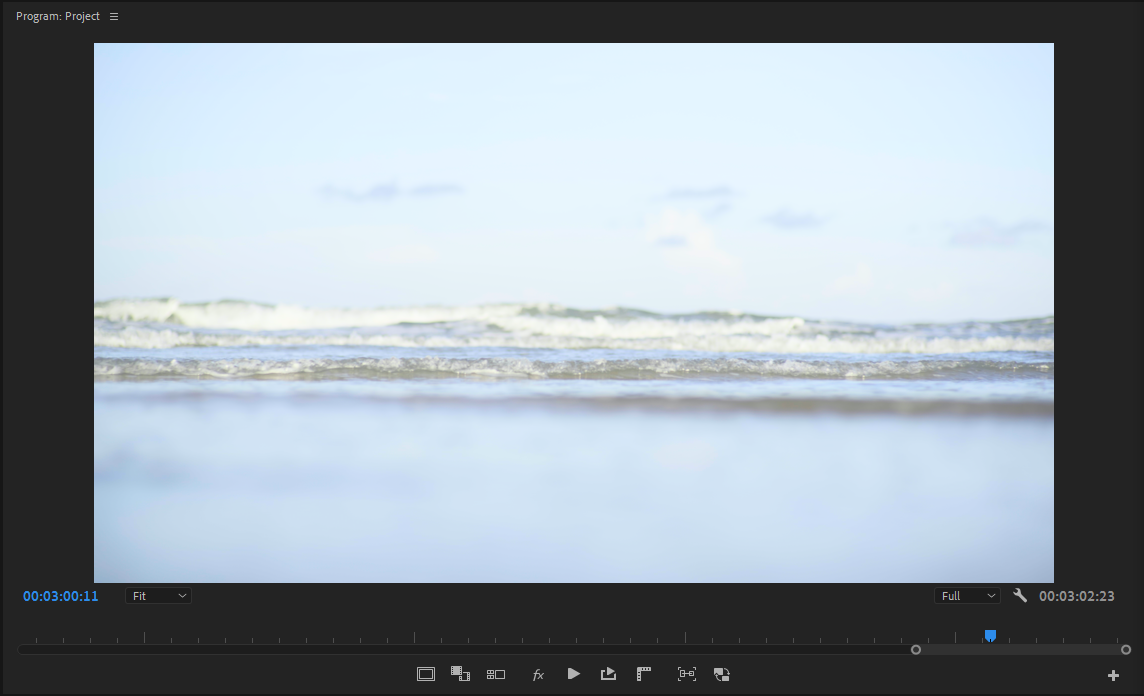
If you don't run into this button, information technology's very like shooting fish in a barrel to add to your UI. Simply click the "+" icon in the lower right of the window, discover the button, and click to add. Also accept the time to explore some of the other buttons in the menu if you've never done so earlier. Alternatively, you tin create a keyboard shortcut.
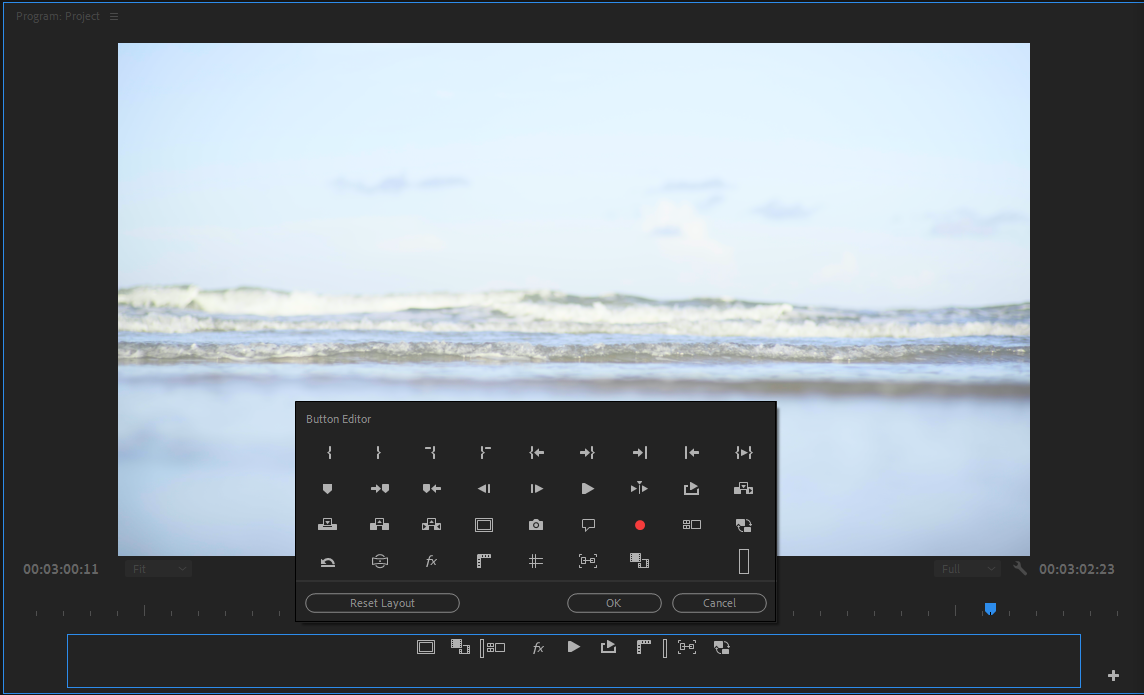
While you're in the Program Monitor, click the wrench icon and notice the option for "High Quality Playback." This pick provides a slightly crisper image in the Program Monitor, though the visual improvement is oftentimes negligible without huge screens. That's why I recommend unchecking this choice, equally the operation hit is usually not worth it.
Lower the Resolution and Use Proxies
At present let's talk resolution. If you're attempting to cut 8K raw media on a laptop, at that place'due south your problem. Very few machines can handle that many pixels smoothly, and so don't feel bad if yous need to use a proxy workflow. In fact, nearly Hollywood workflows notwithstanding cut with proxies, because information technology's so much faster, specially for remote workflows.
Only sometimes proxies aren't enough, and you need to go a step farther. Y'all can also salve some processing power by lowering your playback resolution in the Program Monitor. The frame size of your current sequence volition make up one's mind what options are available in the window'south dropdown carte, only one-half or a quarter is generally acceptable for assembling your edit or fine-tuning a scene.
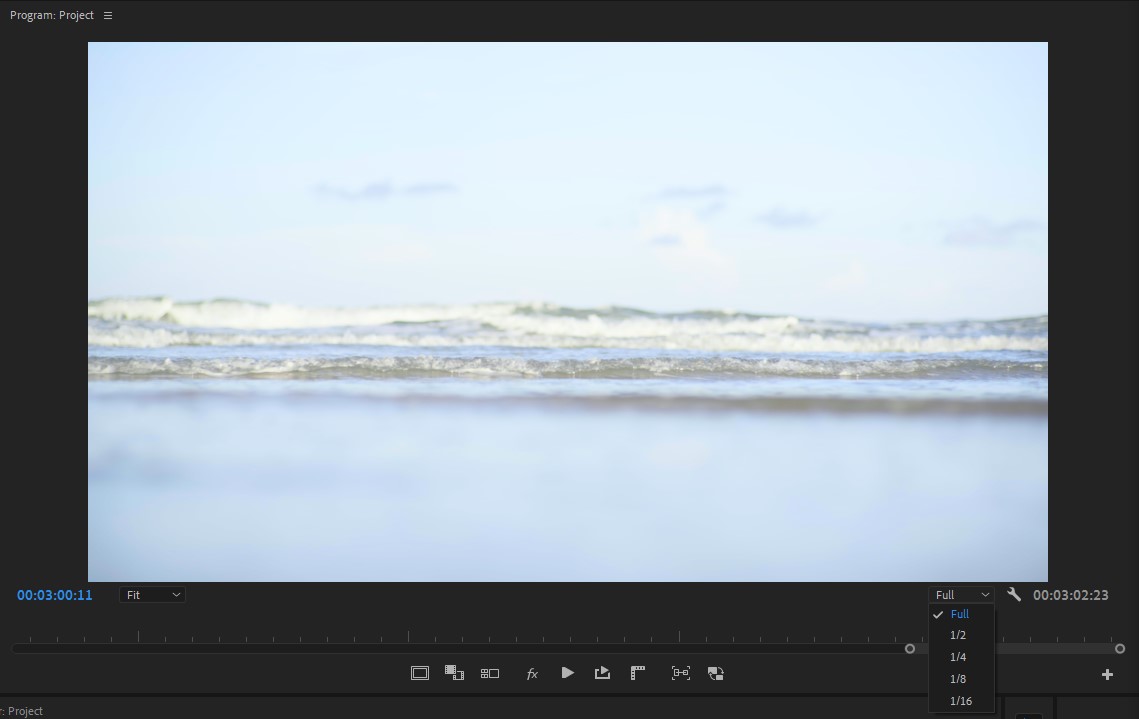
Switch Codecs
Beyond resolution, codecs tin exist a prime culprit of choppy playback. Some codecs, like H.264-based files and flavors of .MXF are very processor intensive due to their use of inter-frame compression. These codecs are more often than not bang-up every bit a delivery format, but terrible for editing. And so if time permits, transcoding your media to an intra-frame codec like ProRes can really speed your editing along.
If you're guilty of right-clicking "new sequence from prune" in the project window so editing your projection in that sequence, then your sequence could be defaulting to some less-than-helpful settings. So, I encourage you to dig a lilliputian deeper into the sequence settings to make sure you're editing media in a quality intra-frame codec, and that your sequence is creating previews files in the same or similar codec.

For instance, I commonly use QuickTime as the preview file format with Apple ProRes 422 as the codec. If you lot want (and this is a stiff recommendation) you can create a custom sequence preset with the settings you need, so you don't have to manually change them for every new sequence.
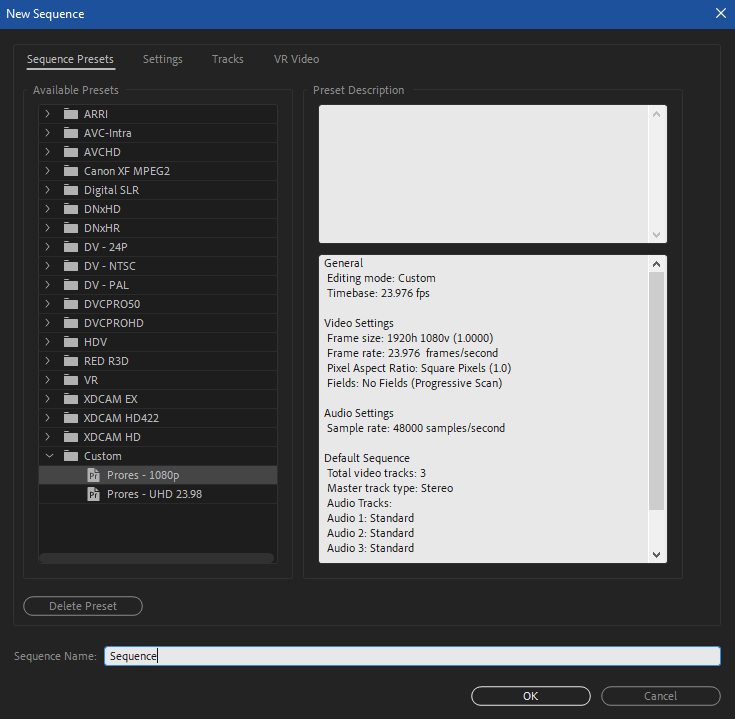
Clear the Cache
Lastly, inclement playback in Premiere could be caused by bad render files and/or enshroud files. If the above solutions haven't solved your playback woes, it may assist to clear these files.
Clearing your sequence's render files is pretty piece of cake. Merely open the Sequence dropdown menu on the program bar and click "Delete Render Files."
With Adobe'south latest 2020 release, information technology is now much simpler to articulate Premiere's cache. All you take to do is open Premiere's preferences and select the "Media Cache" tab, and then click the new "Delete" button side by side to "Remove Media Enshroud Files".
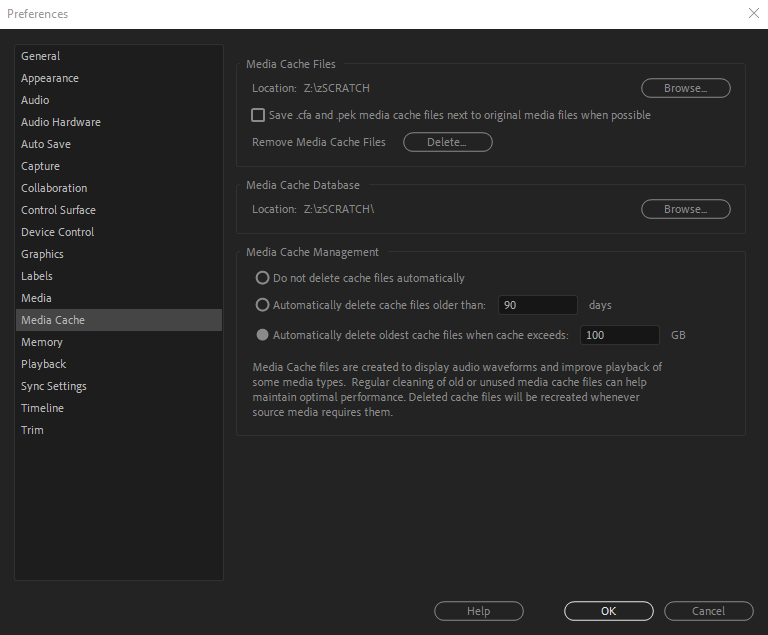
From hither you'll accept two options.
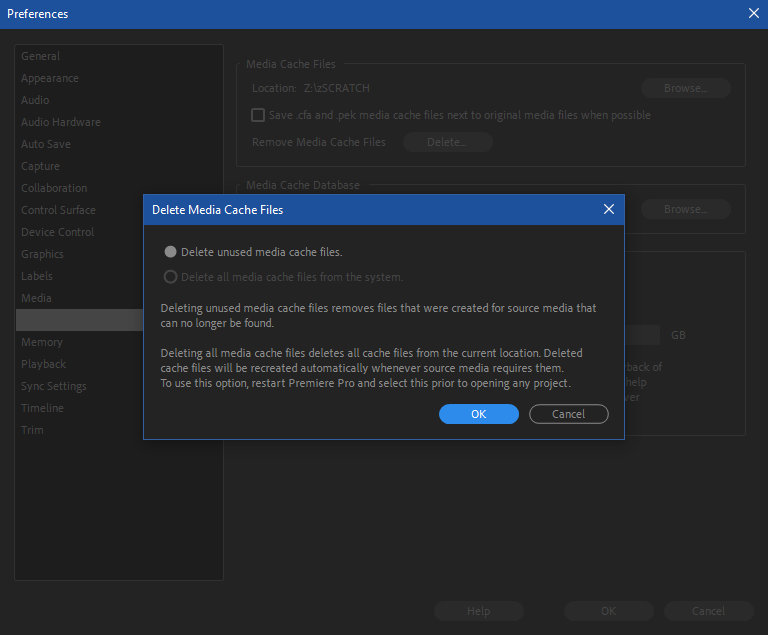
The start, "Delete Unused Media Cache Files" clears all unused cache files in relation to the project you currently have open. The second option can only be selected afterward restarting Premiere without whatever projects open up. It clears the entire cache.
If you prefer the older hands-on approach of clearing the cache, take a stroll into your project's media cache folder and delete the files manually.
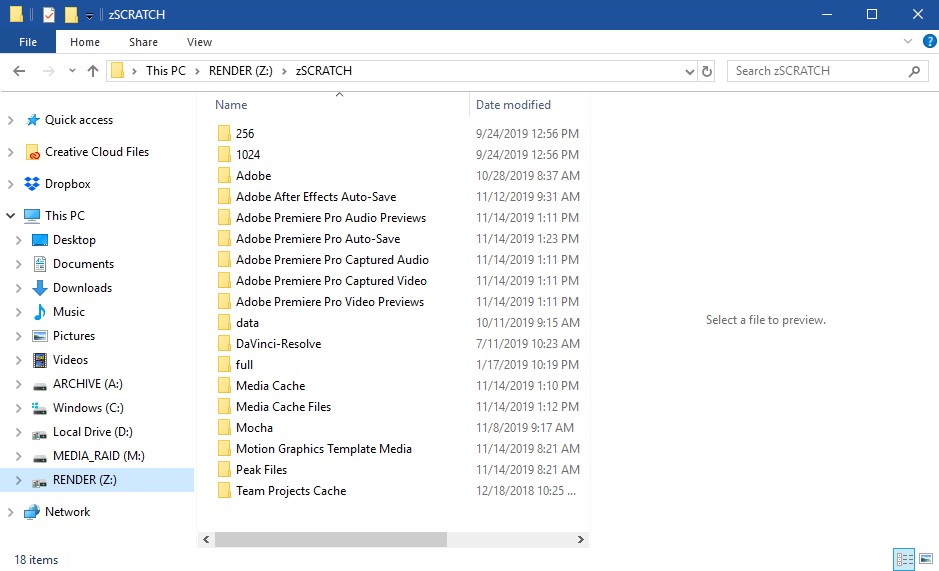
Y'all can delete the folders "Media Cache" and "Media Cache Files" entirely to really make sure your enshroud clears. Don't worry, Premiere will rebuild them.
Stuttering Clips
At present let'southward imagine you're problem is a little bit different than choppy playback beyond a whole project.
Sometimes yous might feel like a clip you've practical a speed ramp to pops or stutters during playback. Or that a sequence with footage of mixed frame rates has certain clips that feel the same issue.
In both instances, this type of clip-specific stuttering is caused by how Premiere is interpolating the footage, rather than a performance issue rooted in your hardware.
Interpolation is the method for how Premiere handles playback of a clip at a different framerate than the actual number of frames per second it was recorded in. These methods usually involve the creation of "missing" frames necessary for a time-remapped clip or mismatched frame rates.
For instance, if you fourth dimension remap a clip from 100% to l%, the clip length doubles, just where do those extra frames come from? That's the work of interpolation.
Mixing frame rates in a sequence is often a necessary evil, specially in documentary work. Say you lot plan to deliver in 23.98fps, just ane/three of your media is 29.97fps. Dropping a 29.97fps clip into a 23.98fps sequence will frequently generate a slight jitter that's nigh noticeable in clips with movement.
Pace back and recollect about what'south happening. Premiere is taking a 1 second 29.97fps clip and squeezing it into a one second slot in a 23.98fps sequence. That'due south basically 6 extra frames per 2nd Premiere has to interpolate. Aside from trying alternative interpolation options, there's not much that tin can be washed to fix this inside of Premiere. Depending on the severity of the jitter, it may exist in your best interest to use a hardware converter, similar the Blackmagic Teranex, to adapt the prune(s) from 29.97fps to 23.98fps.
Interpolation is besides used when time remapping clips. Adobe Premiere offers three interpolation options: frame sampling, frame blending, and optical flow.
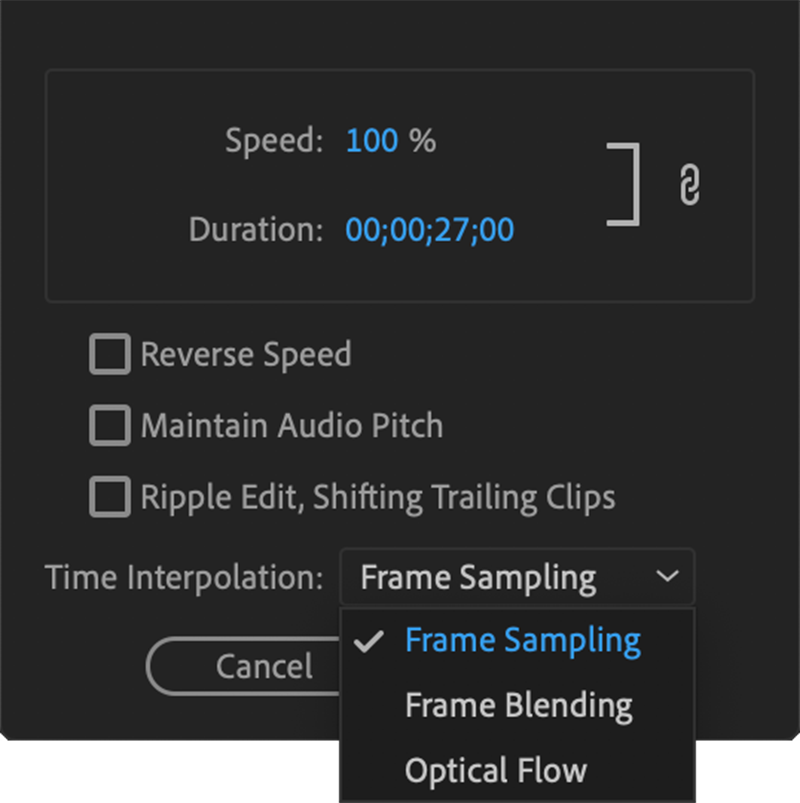
Frame sampling duplicates a frame to brand up for missing frames, frame blending blends 2 frames together to create a new frame, and optical flow uses complex math to brand a best judge at what the missing frame should look similar based off pixel data from within the epitome.
Each method offers a dissimilar look/effect and can be used to help reduce the popping or stutter of a remapped clip. Unfortunately, that is non enough, particularly when slowing a prune downward substantially.
Proper speed ramping usually forces us to practise some pre-planning when shooting video, which sometimes fifty-fifty includes math. Shooting at loftier frame rates allows editors to tedious down footage in mail and helps avoid the stuttery expect. Understandably, there are many situations when the exact speed of a time remapped clip won't be determined until in the edit, but y'all'll need to do your best if y'all're involved with production of the project.
Pretend we're working on a project, planning to deliver in 24fps and shooting in 60fps. For our clips to play dorsum buttery-polish in a 24fps sequence, we demand to know the precise speed to play back each of the 60fps clips and so that there is only one frame for every 24th of a 2d. So, 24 frames per second of playback divided by lx frames per 2d of footage, leaves us with xl% speed. That means slowing each 60fps clip downwardly to 40% speed volition plough those clips into smooth, slow-motility 24fps clips.
If math isn't your matter or y'all just want Premiere to do the work, you can also select the 60fps clips in the Project console, correct click "Modify" and under the "Interpret Footage" tab select "Presume this frame charge per unit:" and type 24fps.
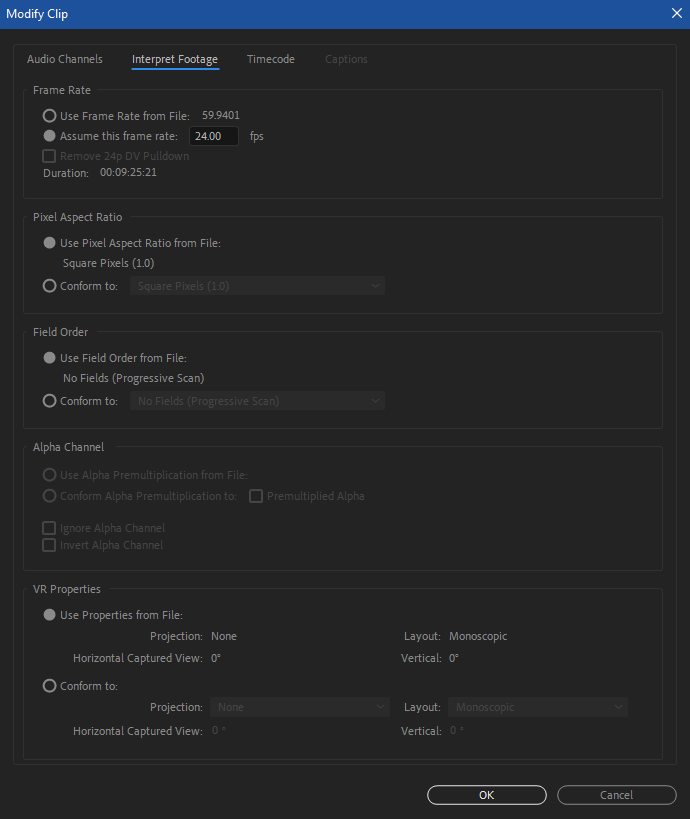
One time you click ok, Premiere will do all the math for you and every clip in the sequence will playback at 24fps. Notation you lot should do this prior to calculation clips to whatsoever timelines equally this plain changes the prune's timing.
Slow Preview Rendering
Despite our all-time efforts, rendering is sometimes the just way to play back a sequence or parts of a sequence in real-time. And depending on what's going on in a sequence, this tin besides accept a while. Outside of the amount of sheer processing power available to your system, the resolution, codec, and amount of effects in your sequence counterbalance most heavily on this issue.
Ane option that may save time is to adjust the video preview settings of your sequence. In your Sequence Settings, the option to change preview size simply affects the previews y'all're seeing inside of Premiere and not the last consign.

So if your sequence frame size is 3840×2160, setting the video preview size to 960×540 drastically reduces the size of the preview files Premiere has to create, which obviously means they take less time. And unless you lot're relying on dedicated preview monitor, you may non notice a huge quality difference in your Program Monitor.
No Video Preview In Program Monitor
If you've been editing along swimmingly and suddenly the Program Monitor only shows blackness while playing back a sequence there'due south a good take a chance the GPU or a bad render/preview file is to blame.
GPU issues sometimes occur when using CUDA or Metallic-based renderers, and and so most oftentimes happen when stacking effects on loftier resolution video. As powerful every bit these cards are, they sometimes striking a snag with intensive workflows.
Normally a program or calculator restart addresses the result, but occasionally they can persist when a certain part of a sequence with heavy effects will always cause the Programme Monitor to go black. If you lot feel this effort changing the renderer in your project settings (File > Project Settings > General…) to employ Software-Only rendering. This option takes your GPU out of the equation.
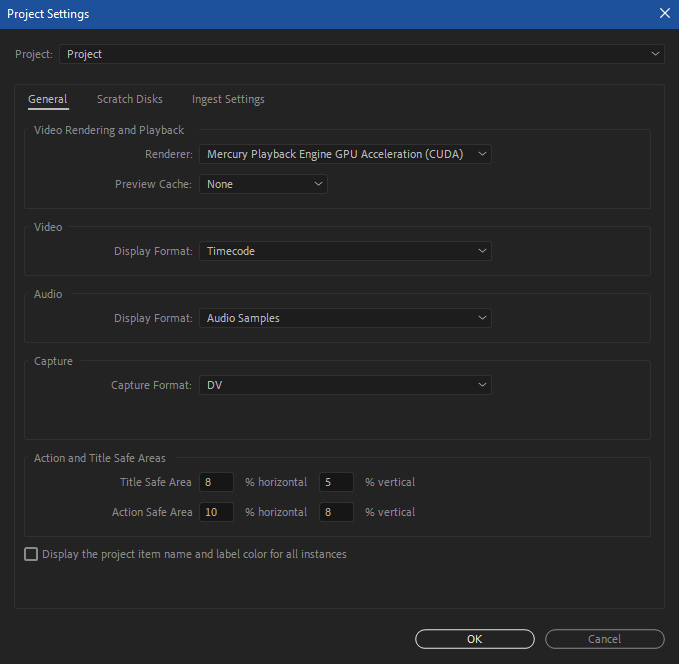
This will most certainly cause a noticeable performance striking, simply you can work similar this in a pinch. You lot can besides mark In/Out on the troubled section of video, render it In to Out, and then export that section of your sequence using preview files in a skillful codec. By cutting this "pre-rendered" chunk dorsum into your sequence on top of the layers that were used to create information technology, you can keep your GPU rendering on without the monitor going black.
Another option to fix lack of video in the Program Monitor is to try clearing the renders/preview cache like we explored before.
Audio Won't Play or Drops Out
Chances are that, if audio playback is inclement or not playing at all but Premiere otherwise seems to be working fine, then your hardware settings have changed. These settings are organisation dependent and tin can be adapted in Preferences > Audio Hardware. Pay careful attention to the Default Output option as it isn't necessarily the same as the organization's default output.
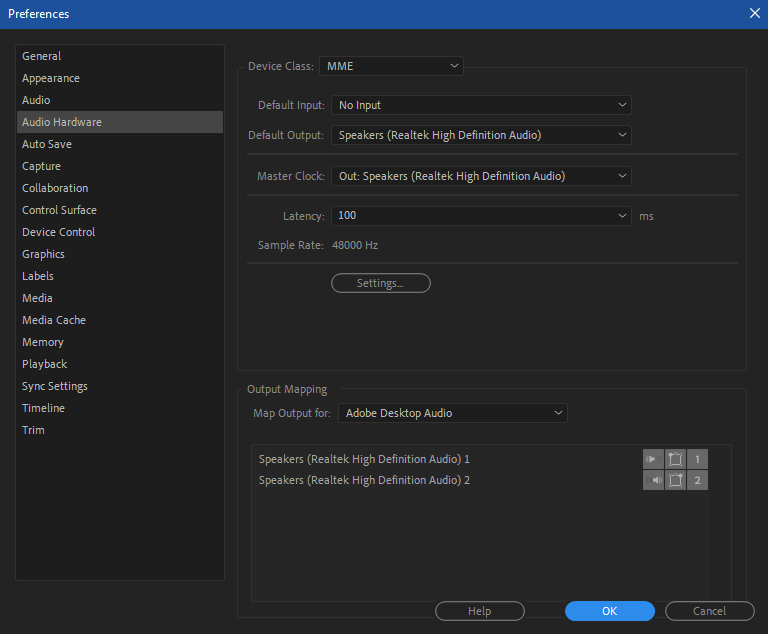
If audio is dropping out as you lot playback a sequence, that could be due to latency or using compressed audio.
Latency is the short delay that'south experienced when an sound signal is processed past a computer and then output to the speakers. You can suit latency in the Sound Hardware preferences, then give that a try if necessary. Smaller values offering lower latency, simply college values can sometimes alleviate sound dropouts.
Premiere can generally handle whatever yous throw at information technology, but some systems may occasionally experience sound dropouts with compressed audio files, like MP3s. The all-time way to avoid this is to either utilise an uncompressed audio file, like .WAV or .AIF, which are easy to convert to.
Mutual Export Issues
Now permit'south imagine some other problem. Y'all've finished editing your project, but you can't go the blasted thing to export correctly. Let'south have a look.
Error Messages Defined
Sometimes Premiere will practice y'all a favor and spit out an error code nigh an consequence. These messages do a decent, albeit still frustratingly inconsistent, job of titling errors in a meaningful mode (at least for export/render issues).
If you don't know what an error actually means, just consult the listing to get to the bottom of it.
Simply allow's assume you didn't get a clear error message. Here are some common causes for export problems in Premiere Pro
The Usual Suspects
Every bit we've already covered, the nigh common operation problems revolve around codecs, GPU processing, write locations, effects, and corrupt media. Too, export errors involve the same sorts of things. We've already covered codecs pretty well, so allow's jump back to GPUs.
GPU Rendering
If you lot remember the GPU is causing your exports to fail (similar it can with render previews), so endeavour disabling hardware render settings in your projection'southward render setting. Again, software-only rendering will exist slower, but it may let y'all to consign the sequence without failure.
Write Location and Permissions
Write location issues generally stalk from not having enough space available on a drive to write to the file. Simply they can besides involve permission mismatches. Evidently, the uncomplicated solution to the one-time is just to make certain you have enough space available at the write location prior to exporting.
Permission problems can be particularly prevalent in networked environments. (They tin pop upward on solo machines as well.) They can be a real pain to solve if yous've never encountered them before. The exact cause and solution of these problems is dependent on a number of factors, and are a flake more granular than nosotros'll cover here, but there are lots of resource out in that location for solving common Mac and Windows permissions issues.
Troublesome Effects, Again
Too many furnishings can give u.s. a lot more than grief beyond just choppy playback. If your exports are failing, information technology'due south possible there'southward a troublesome effect hiding in your timeline.
Information technology's easy to exam this. Turn on the "Global FX Mute" option and try to export your sequence. If it exports fine without effects, then there's a problematic outcome or corrupt slice of media amidst your clips.
But at the end of the day, y'all probably need the effects on your timeline. So y'all demand to observe it and fix it.
So disable "Global FX Mute," and mark an in point at the showtime of the sequence and an out point in the middle of the timeline. Now effort to export that portion.
If it works, then you know the troublesome effect is not in the first half of your sequence. At present test the 2d one-half. So make an in point in the middle of your sequence and an out point at the end. If it fails to consign here, you know the bad effect is in that half (though you probably already knew that since the first half exported fine, this just confirms information technology).
Now it'due south fourth dimension to hone in on the bad issue, so repeat this procedure over again by exporting half of the failed in/out points. If it exports fine, the bad effect is in the last quarter of your timeline, and if it fails, y'all're closer to finding information technology. You get the idea.
In one case you've found the problematic prune or event, return it and export it individually, both with and without effects. In one case you have a rendered file of the troublesome prune, just import it into your timeline and insert information technology above the offending prune (which y'all may demand to disable). Now you should be able to export your timeline without whatever issues.
Nuclear Options
Unfortunately, there are times when engineering science will get the best of us and nosotros are left with uncomfortable choices.
We're fortunate every bit video editors that this isn't life and death – merely lost time and productivity. But it'south a difficult choice nonetheless if y'all're approaching deadline and Premiere yet has operation bug.
For times such as these, here are the final, nuclear options to consider.
Clear Premiere Pro's Preferences And Plugins
Resetting Premiere Pro back to its original state may be the cure for your ills. Of course, trashing all your preferences and customizations is painful, but information technology may exist your but pick.
But before you reset Premiere Pro, first try clearing the plugin cache. Plugins are great, but sometimes they don't play dainty with the latest update. Or they develop bugs of their own. To clear their cache, concur Shift+Alt (Windows) or Shift+Option (Mac) while launching Premiere until the splash screen appears. And if this doesn't piece of work, try removing and re-adding plugins to Premiere.
But if that still doesn't work, it'south time to reset Premiere's preferences entirely. Concord Alt (Windows) or Option (Mac) while launching Premiere until the splash screen appears. Prayers are optional in this step.
When All Else Fails
If none of the higher up has solved your Premiere Pro playback issues, I apologize and mourn your situation. At this point, your simply option may be to uninstall and reinstall Premiere Pro. Information technology sucks, just sometimes years-old installs need a fresh start. Make certain all your projects are saved and backed upwards externally. Then use the Creative Cloud desktop app to remove and perform a clean install of Premiere Pro.
If after this terminal finish you're still having performance bugs, it's likely you have a deeper hardware or workflow result. It'due south time to call in an expert to wait at your situation. Godspeed.
The Road to Recovery
Solving technical issues can be a painful process. It'due south confusing, disruptive, and sometimes mind-numbingly boring. When a customer or producer is breathing down your neck to end a project, it's massively stressful.
But at the cease of the day, it's our job to continue our tools in shipshape. We need to have charge of our workflows and equip ourselves with the cognition to fix our own problems. If we can do that, nosotros'll feel more comfy with our technology and more confident in our abilities. Plus, showing off a little technical prowess can definitely impress clients and coworkers. And that can inspire them to work with you downward the road.
Now y'all should be prepare to tackle some of the most common problems you're probable to face in Premiere Pro. And so become forth and conquer those workflow bugs!
Choppy playback isn't the only issue with Premiere Pro. Are in that location whatever common issues we left out? Allow us know in the comments, and share your solutions with the community. We love hearing from our readers, and learning from your incredible creativity and experience.
Source: https://blog.frame.io/2019/11/18/diagnosing-premiere-pro-problems-choppy-playback/
0 Response to "Can I Use the Same Clip Again if I Interperate Footage in Premiere"
Post a Comment